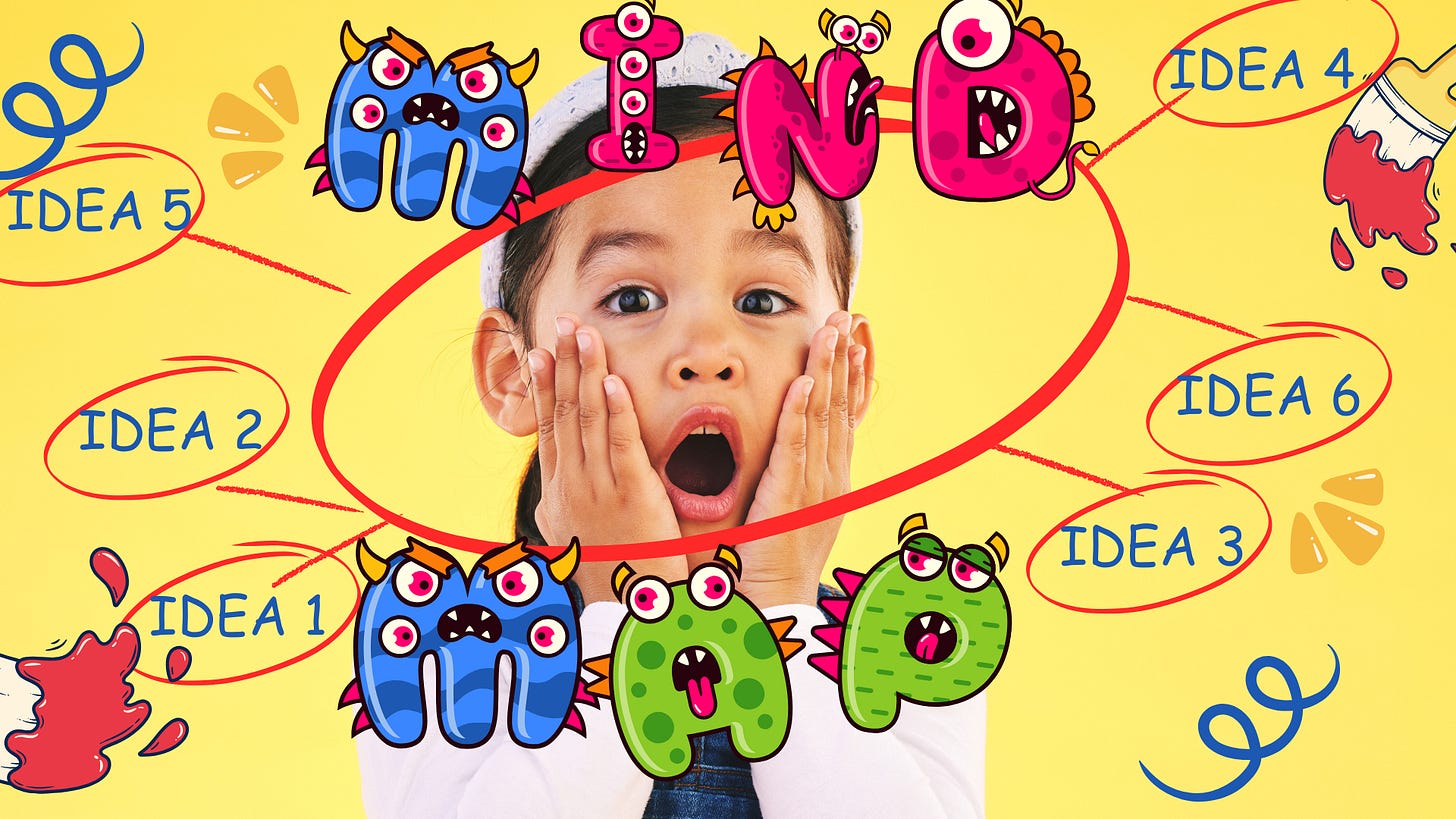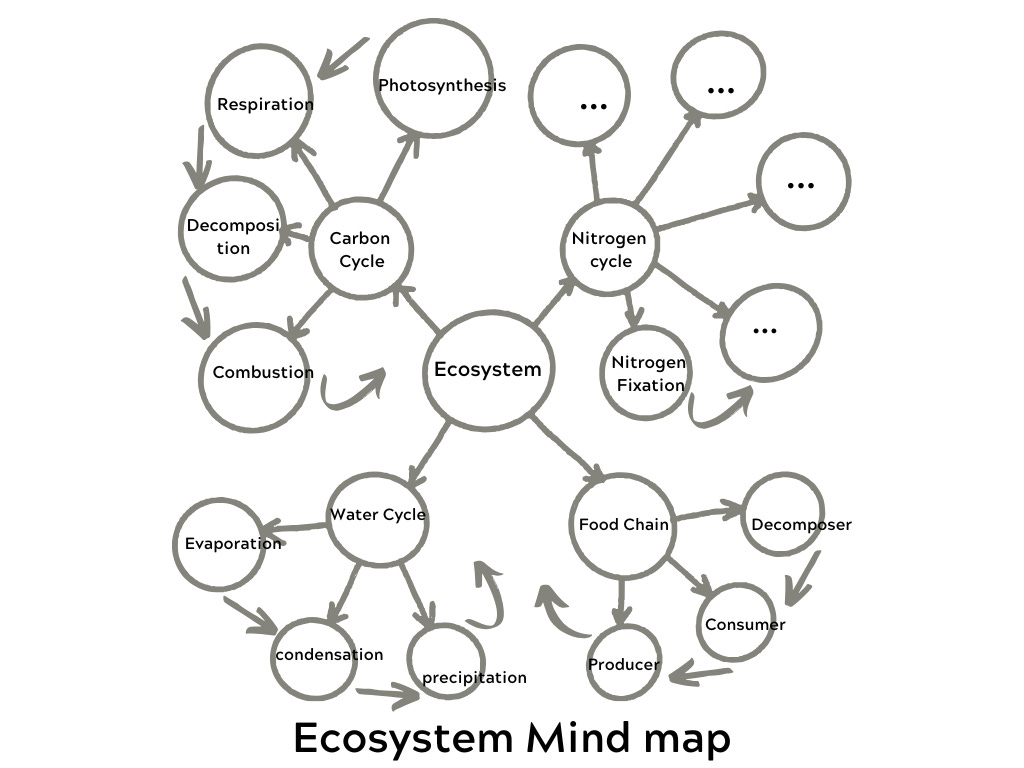How to Use Mind Mapping Techniques for Learning
teach your kid to organize their thoughts and build a web of knowledge
Is your kid overwhelmed? Do they feel like the amount of new information to learn is too much, unrelatable, and uninteresting?
Kids are faced with learning new subjects, new ideas, new vocabulary… daily. It can be daunting. Especially when each new fact seems like an isolated idea to memorize.
Kids need ways to group and connect new information, organize ideas, and build a ‘knowledge map’ that links new ideas to already known concepts to reduce their overwhelm and frustration.
Imagine your ten-year-old self learning about ecosystems and food chains. And feeling overwhelmed by the amount of information. So many different terms and new ideas. You might feel lost trying to understand how they all relate…
First, you have producers, consumers, and decomposers. Then, there are all the relationships between plants, animals, and their habitats. How do they all relate? And what’s the difference between a food chain and an ecosystem anyway?
When kids are expected to learn new information as separate terms and individual ideas without understanding the connections between things, it can feel like cognitive overload. And like the new ideas have no relevance, they are just a lot of random bits of information to memorize.
Without connections, it is hard to memorize lots of new facts.
But when kids make connections between ideas and start grouping them together into a ‘Big Picture,’ it is far easier both to understand and retain the information. This is because they start to build a web or ‘map’ of knowledge. They do this by adding new information to their map of already-known information.
One of the best and most fun ways to help kids do this is mind mapping.
It is an ideal learning tool because kids can use it at every stage and age. It taps into how we think and learn. It is intuitive. It helps kids visually organize ideas so they see the relationships between new concepts and have an easier time remembering, understanding, and using new ideas. Mind mapping can also help build agency, independent learning, creativity, and problem-solving skills.
What is mind mapping?
Mind mapping is a concept introduced by Tony Buzan. In his book, The Mind Map Book: Unlock Your Creativity, Boost Your Memory, Change Your Life, he explains how it can be used as a tool for learning, brainstorming, memory retention, and problem-solving.
It is similar to brainstorming. But takes brainstorming a step further by organizing ideas visually around a central idea. The central idea is the Topic. Each of the other related ideas becomes a Subtopic. In turn, ideas related to each Subtopic can be grouped around the Subtopic. This process creates a visual map of how ideas are connected.
Buzan believed that traditional, linear methods of organizing information and learning individual facts don’t align with how our brains naturally think. He argued that our minds are wired to work visually and by making associations. Our minds link ideas in a non-linear ‘network’ rather than in isolated, step-by-step sequences.
Mind mapping taps into our brain’s natural ability by prompting us to organize ideas around a central concept, with related ideas branching outward. This helps us form connections and patterns that are easier to understand and remember.
Mind mapping can help your child learn almost any topic more easily. This is because it makes complex information manageable by grouping it into bite-sized chunks or related ideas. It also sparks kids’ creativity and independent thinking and helps them build a ‘web of knowledge’ over time.
The reason it is so effective is because it is visual, non-linear, and focused on creating groupings that connect ideas and reduce overwhelm. New ideas are not a pile of a jumbled and overwhelming facts. Instead, they are connected back to a central theme in a way that kids can make sense of.
The power of visual organization
Visual organization is similar to the natural way kids learn. According to Justin Sung, creator of metacognition-based study techniques for students, grouping ideas and building a knowledge map reduces cognitive load. It makes it easier for kids to process and retain new ideas. This is because they can see where the ideas fit.
Imagine your ten-year-old self again.
And now, instead of a zillion new ideas and big words like ‘decomposer’ that you have to memorize, you can create a mind map and start piecing together how each idea fits with the central theme of a food chain.
You can build as many mind maps as needed to piece ideas together.
For example, maybe you’ve created a visual representation of the main Topic--food chains--and all the Subtopics related to it. Next, you could think of the Food Chain itself as a Subtopic of a bigger central theme: the Ecosystem.
Now, the many vocab words and new ideas start to make sense because they are connected to the Big Picture—visually.
You can draw a bubble around each idea, maybe use different colors, and add arrows, drawings, and short definitions to your mind map. This will help to visually describe a complete picture of how producers, consumers, and decomposers are all related in a circular pattern, a cycle that makes up the food chain.
Next, you can repeat the process of how the food chain, the water cycle, the carbon cycle, etc., are all connected to the Ecosystem. And suddenly, as if by magic, it is not as hard to remember all the things.
Why? Because the myriad of new terms and definitions are no longer in isolation—they now all fit together in the ‘ecosystem’ or ‘knowledge map’ your child created.
Why mind Mapping works for kids
Mind mapping builds a web of knowledge.
It helps kids see how ideas interconnect. This enhances both memory and understanding. When kids use a mind map to organize new ideas, they link them to what they already know. This process reinforces learning because they start to teach themselves how various ideas all relate back to the ‘Big Picture.’
Benefits of Grouping and Connecting Ideas
When kids practice grouping similar ideas together, they are simplifying complex information into simple, relatable groupings. This makes it easier to understand and remember.
Let’s say your ten-year-old is the one developing a mind map of food chains. The ultimate goal is for them to learn about how food chains fit into the big picture of a specific ecosystem. Your child starts with a mind map of food chains, putting that word in the center, then placing terms like decomposer, producer, and consumer around the central term.
Then maybe they add the names of various animals and plants in that particular ecosystem—and connect each to the role—decomposer, producer, consumer—that it plays. They can color-code the map to help them track which animals connect to which role.
Building a map of visual relationships
The first draft might look messy as they work out the connections.
They can redraw a new map and organize animals around the Subtopics—the roles. Once they’ve created this knowledge map, just through the process of visually organizing ideas, they will have taught themselves a great deal about food chains.
Now, suppose they draw arrows between the Subtopics that surround the central topic. They will now ‘see’ how the food chain works.
Next, they can build another mind map. This time, ‘Ecosystem’ is in the center as the main Topic. Food chains will be a Subtopic. They are in the process of expanding their mind map---and their understanding of the connections between ideas.
The process of creating a mind map is, again, a process of building their knowledge map. It will be far easier for them to remember because by organizing and grouping information, they are teaching themselves to see patterns and relationships between topics.
Pause for a minute and imagine your child creating an ecosystem mind map.
How ‘Subtopics’ work
What Subtopics might they list? What direction might they take the concept? What ideas might they want to explore based on what they know? The visual nature and the fact that it is fun to create sparks kids’ imaginations…
Here are some Subtopics your kid could write down around the central topic of Ecosystems alongside Food Chains:
Types of Ecosystems
Forest
Desert
Ocean
Grassland
Freshwater
Habitats
Specific habitats for certain species (pond, canopy, forest floor)
Cycles in Nature
Water Cycle
Carbon Cycle
Nitrogen Cycle
Adaptations
Physical Adaptations (e.g., thick fur for cold environments)
Behavioral Adaptations (e.g., migration, hibernation)
Human Impact
Pollution (air, water, soil)
Deforestation
Climate Change
Conservation efforts
Biodiversity
Importance of biodiversity
Examples of diverse species within ecosystems
The possibilities are... almost endless. Your kid could keep exploring through a visual process of linking topics and grouping ideas together. Maybe you want to help them focus on ‘cycles’ within an ecosystem. The subtopics might include food chains, the water cycle, the carbon cycle, and the nitrogen cycle.
But maybe your kid, seeing the possibilities, wants to run with it and explore different types of ecosystems… Great!
Maybe they add:
Forest
Desert
Ocean
Grassland
Freshwater
…as Subtopics around the central theme or main Topic of ecosystems. They are using their creative and critical thinking to explore, make connections, and map out how things fit together.
And this is the real goal—your child actively teaching themselves and building their web of knowledge.
How mind mapping helps kids become independent learners
When kids create their own mind maps, they have more agency in the learning process.
They decide how to structure their ideas, what connections to make, and how to visually represent their thoughts. This choice-making strengthens their ability to brainstorm creatively and solve problems.
The next time your kid gets excited about brainstorming subtopics around a central theme, let them! And watch where their imagination goes and how they connect ideas!
Use mind mapping to brainstorm, think creatively, problem-solve, and build knowledge
Mind mapping gets kids to tap into their creative thinking abilities.
It helps kids brainstorm so they can get into a state of flow. They can write down almost any idea that comes to mind and then challenge themselves to figure out how it connects.
They are using a ‘curiosity gap’ to build knowledge.
Here is the process:
Brainstorm ideas
Write them down anywhere
Challenge themselves to group similar ideas inside circles
Challenge themselves to make and draw links between groups of ideas
The groups of ideas spark curiosity. Drawing links closes the ‘gap’ and makes a new connection.
The process teaches kids problem-solving skills. They puzzle out how to link ideas. They use their map of known information and place new information in relation to it. On a micro-level, this process of training their minds to see relationships is building strong problem-solving skills.





